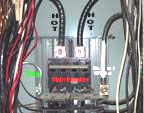On this discussion we are not talking about Industrial applications. There are 208-volt 240-volt and 480-volt 3-phase services. The 240-volt Residential is different from a 240-volt 3-phase service.
There
are four wires involved with supplying the main panel in your
house with power. Three of them will come from the utility pole, and a
fourth (bare) wire comes from elsewhere. The bare wire is connected to one
or more long metal bars pounded into the ground, or to a wire buried in
the foundation, or sometimes to the water supply pipe (has to be metal,
continuous to where the main water pipe enters the house) This wire
normally carries no current. (Click
on Photos to Enlarge)
 |
 |
 |
One of the other wires will be white (or black with white or yellow stripes, or sometimes simply black). It is the neutral wire. It is connected to the "center tap"
The other two wires will usually be black, and are the "hot" wires. They are attached to the distribution transformer as well.
According the NEC, the "grounding" conductor is for the safety ground the green or bare or green with a yellow stripe wire. The word "neutral" is reserved for the white when you have a circuit with more than one "hot" wire. Since the white wire is connected to neutral and the grounding conductor inside the panel, the proper term is "grounded conductor". However, the potential confusion between "grounded conductor" and "grounding conductor" can lead to potentially lethal mistakes - you should never use the bare wire as a "grounded conductor" or white wire as the "grounding conductor", even though they are connected together in the panel.
The codes for residential installation requires a ground wire for many years on 120-volt plugs.
|
10-50R |
However a ground wire on a RESIDENTIAL installation of a 120/240-volt service outlet for appliances in most cases until recently was not required. For more information read the "Appliance Service" on the left. This service is usually a three-prong plug without a ground called a 3 pole 3-wire service. |
|
The body of the appliance MUST be grounded separately to a ground source like a cold water pipe. Important Note: In the US, the NEC used to permit the 3 wire circuit to be used for stoves and dryers - namely, three conductor wiring, with a ground wire doing dual duty as a neutral. As of the 1996 revision to the NEC, this is NO LONGER PERMITTED in new constructions. |
